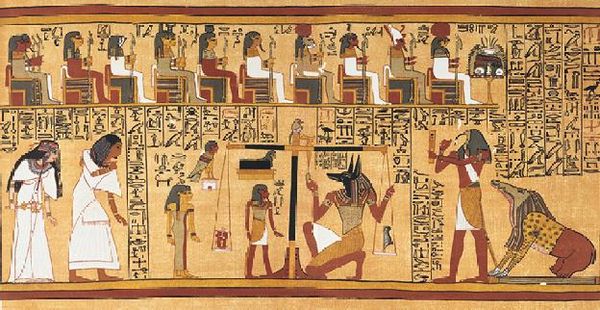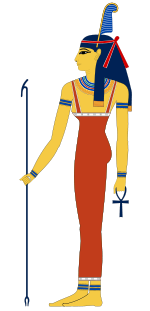| Major cult center | Symbol | Parents | Consort |
| All ancient Egyptian cities |
~
(the Shu) ostrich feather.
|
Ra [and ?] | Thoth (in some accounts) |

|
|
~~
|
|
Ma'at observing the Weighing of the Heart as measured with
the Ostrich Feather of Truth.
The major Gods are in attendance (seated above) with Thoth (standing behind Anubis) noting the result. |
|
The weighing of the heart, usually pictured in the
Book of the Dead, or in tomb scenes, shows Anubis oversee-
ing the weighing and the lioness Ammit seated awaiting the results noted by Thoth so she could consume those who failed. The image would be the vertical heart on one flat surface of the balance scale and the vertical Shu-feather standing on the other balance scale surface. Other traditions hold that Anubis brought the soul before the posthum- ous Osiris who performed the weighing. [This Image is from: 'The Papyrus of Ani'] |
|
Creator. From an early period the King would describe himself as the "Lord of Maat" who has decreed with his mouth the Ma'at he has conceived in his heart. 'The one. "who reveals Ma'at and reckons Ma'at; who loves Ma'at and gives Ma'at to the doer of Ma'at."' |
|
sitting or standing, holding a scepter in one hand and an ankh in the other. Sometimes she is depicted with wings on each arm or as a woman with an ostrich feather on her head. Depictions of Maat as a goddess are recorded from as early as the middle of the Old Kingdom (c. 2680 to 2190 BCE). set his daughter Maat in place of Isfet (who personified Chaos). Kings inherited the duty to ensure Maat remained in place and they, with Ra, are said to "live on Maat". Here, Akhenaten (r. 1372-1355 BCE) in particular emphasised the concept. Some of them incorporated Maat into their names, being referred to as: 'Lords of Maat,' or: 'Meri-Maat' (Beloved of Maat). When beliefs about Thoth arose in the Egypt- ian pantheon and started to consume the earlier beliefs at Hermopolis about the Og- doad, it was said that Maat was the mother of the Ogdoad and Thoth the father. Egyptian underworld, the hearts of the dead were said to be weighed against her single Shu feather, symbolically representing the concept of Maat, in the Hall of Two Truths. A heart which was unworthy was devoured by the goddess Ammit and its owner con- demned to remain in the Duat. Only those people with good and pure hearts were sent on to Aaru. Osiris came to be seen as the guardian of the gates of Aaru after he be- came part of the Egyptian pantheon and displaced Anubis in the Ogdoad tradition. |


![D36 [a] a](Ma'at_Wiki_ex_files/hiero_D36.png)
![X1 [t] t](Ma'at_Wiki_ex_files/hiero_X1.png)










